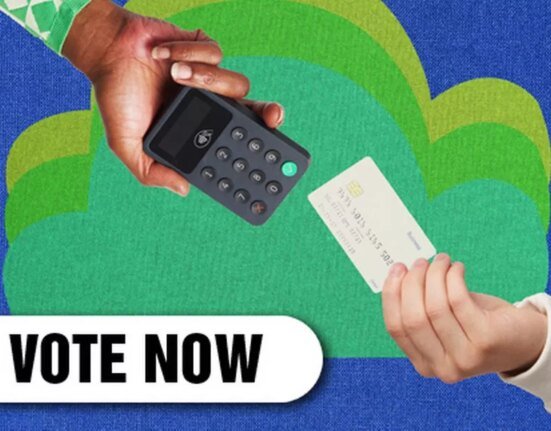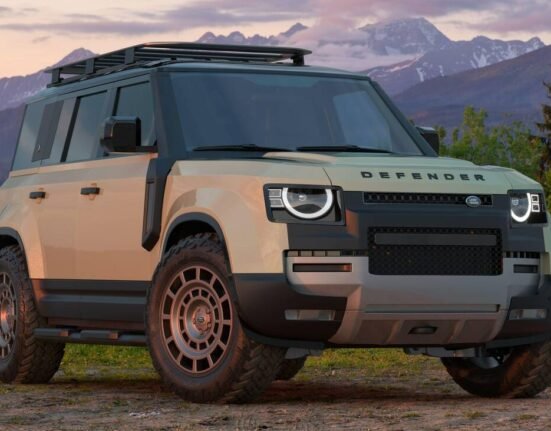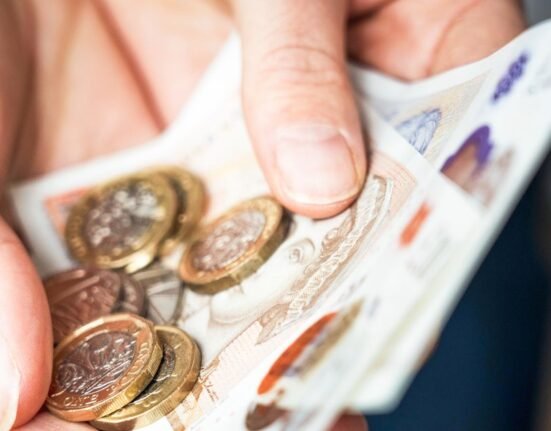A couple of years ago, Starbucks made an assumption. If it invested in equipment, it could offset the removal of labor. Upgrades like its Siren System, designed to speed drink production and streamline operations, from custom ice dispensers to faster blenders, would cover for fewer employees in stores. A leaner, more efficient vision of Starbucks.
But it didn’t turn out that way, CEO Brian Niccol, who joined the brand from Chipotle in September, told investors Tuesday during the company’s Q2 earnings.
What happened, compounded by ongoing price hikes (taken for myriad reasons and not expected for the remainder of 2025), is Starbucks’ lost grip of its guest-centric focus. And there was a more recent revelation—equipment didn’t solve the customer experience needed to win in this inflationary environment and long-term. “Rather, staffing the stores and deploying with this technology behind it does,” Niccol said.
There are many levers of the chain’s “Back to Starbucks” plan, yet this core redirect runs through the center of all of it. Starbucks’ U.S. same-store sales declined 2 percent in Q2 on traffic declines of 4 percent and average ticket growth of 3 percent. Earnings per share of 41 cents, down roughly 40 percent year-over-year, came in well below Wall Street estimates. Niccol cautioned investors EPS wasn’t the proper metric to track Starbucks’ comeback given investments. Instead, he pulled out a few examples of what’s evolved.
With labor, “delivering the customer experience to win the peaks” has pulsed throughout Starbucks’ turnaround. Back in Q2 2024, the chain witnessed a mid-teen percent order incompletion rate within its mobile order and pay business. That meant guests were tapping the option, putting items into their cart, and then choosing not to hit send, “citing long wait times of product and availability.”
Given more than 60 percent of Starbucks’ morning U.S. business flows from rewards members, who, naturally, tend to order from the app, this was a flashing sign the brand was ceding share at critical windows.
Niccol said the brand, using a test-and-scale approach, shifted focus from beverage production to “craft and connection.” In other terms, it looked at solving the issue through investments in labor rather than equipment, and how it could become more effective at fixing throughput and driving transaction growth through its people. Learnings in Q2, Niccol added, came from a 700-coffeehouse staffing and deployment pilot.
This test showed sizable improvement in speed of service and transactions as average wait times fell by two minutes, and 75 percent of stores attained Starbucks’ targeted wait time of four minutes at peak. Improvement ranged from in-café to drive-thru, without hurting mobile order experience.
The “right staffing” was one piece of the jigsaw. “Deployment”—a core Chipotle focus during Niccol’s tenure to rebalance digital and in-store following the pandemic—was another. The final, a new order sequencing algorithm.
Combined results proved compelling enough for Starbucks to pin May as the starting point to scale a fresh “green apron service model” to more than 2,000 U.S. company-operated stores by the end of fiscal 2025. Again, it combines and unifies new service standards and expectations, changes to employee deployment, streamlined routines, and the company’s evolving order sequencing algorithm. Niccol said he’s confident it “will create more flexibility within our operation, improve peak throughput, better capture demand, deliver a more premium customer experience, and accelerate transaction growth.”
As Starbucks bolsters deployment and tech support (the brand is also planning to push an update to its app this summer to allow guests to schedule mobile order pickup that will improve price transparency throughout the process), Starbucks realized the equipment development of past years, as noted, had to be rethought. Siren is far from a CapEx-light initiative. Niccol said the chain decided to pause the rollout of Siren’s cold and food equipment and chose not to move forward with the deployment, in particular, of the cold press, cold brew equipment.
However, Clover Vertica, a six-hopper system that doesn’t require paper filters and can serve a cup of coffee on demand in less than 30 seconds, is currently in 70 percent of corporate units and remains on track to fully roll out.
Starbucks’ “green apron service model” is something Niccol views making it to all corporate U.S. units. But it will take different forms. Urban and suburban stores simply don’t require mirrored labor approaches. That’s contingent upon the business. Niccol recently was in downtown Chicago, for example, where the labor pilot was running. A lot of transactions. Big mobile business. So Starbucks, fittingly, added a lot of labor against the mobile order side of the business. It’s a unit, he explained, doing 250 transactions in 30 minutes.
The restaurant leader increased labor toward peak and shoulder hours, and primarily in the mobile ordering space. And the algorithm worked behind the scenes, managing how orders flowed.
Then, Niccol offered an anecdote from a suburban Starbucks. What this restaurant saw success with was committing a person to be stationed at the drive-thru and nowhere else. “We’re going to need to move both the labor and the deployment to match what the business actually flow looks like,” he said. “And what’s great to see is in both of those scenarios, which are two very different stores, you’re seeing transaction growth, you’re seeing a team that’s highly engaged, highly energized, I think moving with simplicity, moving with connection, and then also just moving to our customer, which is really exciting.”
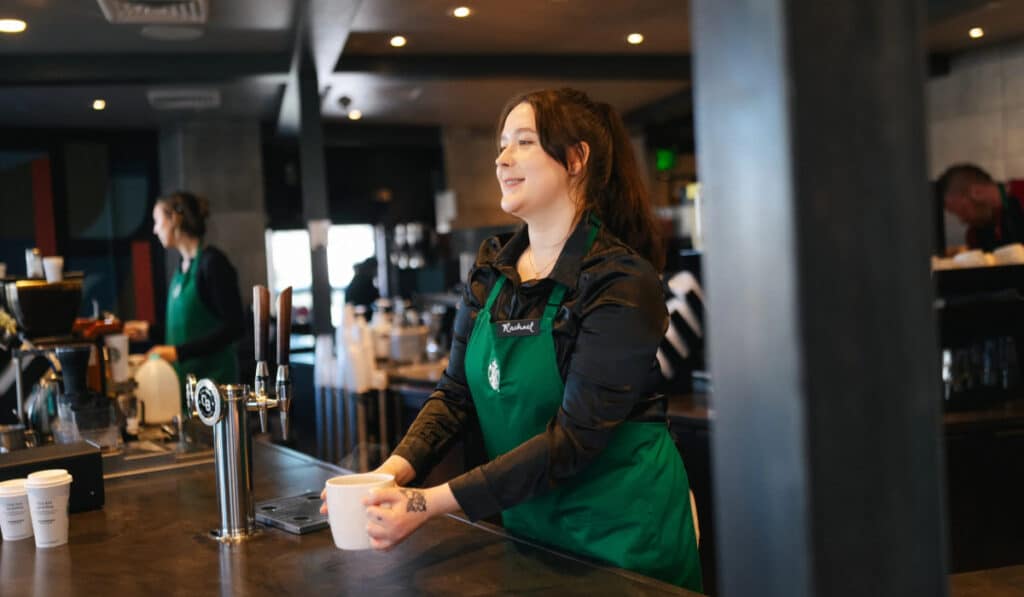
Speaking more on mobile order and pay sequencing, Starbucks’ new algorithm test has expanded from three stores to more than 400. Niccol said it’s yielding mobile order times below the company’s 15-minute threshold (where attrition accelerates on the app).
He said Starbucks averaged less than four minutes in the drive-thru and pulled out about two-and-half minutes in-café. About 75 percent of pilot stores are achieving what he calls the “4, 4, 12” metrics (four minutes to get a drink in-store or at the drive-thru and 12 via digital), “without having anybody be dissatisfied with the time of their mobile order experience.”
Also, a positive spin, Niccol said, is it happens behind the curtain for employees. The tech figures out how to route orders to the store and to certain stations. So when employees pull out tickets, the tech has done the work so they’re seeing the right drinks to make. In response, Niccol said, they’ll be successful hitting speed times and having the ability to connect with customers.
“One of the things that really is fun to see in these stores is it’s just a lot calmer,” he added. “People move with purpose, but it’s a lot calmer. There’s the opportunity to provide great connection and that’s really what we want the technology to do behind the scenes—is just be there behind the scenes so that our partners are set up for success to connect and do their craft with our customers on every transaction.”
Starbucks’ identification of this issue was a quick one in Niccol’s early days, too. Last quarter, he said it became clear order sequencing was responsible more for bottlenecks than capacity. Put differently, Starbucks’ failure to deliver throughput wasn’t entirely a product of how busy restaurants were. The opportunity to speed up service lied in staffing and deployment and algorithm technology. Starbucks began to segment locations by transaction volume and started its test of in-store prioritization as it explored tech investments capable of improving order sequencing and behind-the-counter efficiency.
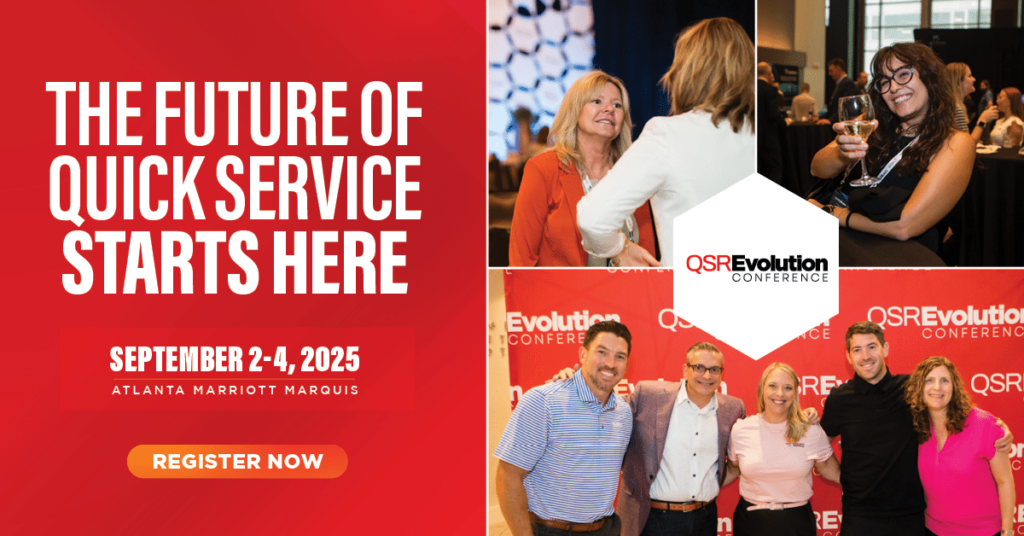
Beyond getting drinks to guests faster, Niccol said these efforts surged employee engagement. Turnover in Q2 dropped to less than 50 percent—a new recorded low for Starbucks. Transaction declines also slowed across dayparts and “quality transactions” drove a larger portion of sales as Starbucks moved away from some of the discounting that preceded Niccol’s arrival.
This past quarter, the brand launched an update to its “Shift Marketplace,” which allows employees to pick up and trade blocks within their district. That increased the pool of workers to fill last-minute changes by 10X and resulted in record-high shift completion, Niccol said, with 500,000 more shifts filled, year-over-year.
As part of the broader theme, this, too, translated into more “moments of connection,” he noted, higher transaction capture, and a better employee experience.
Niccol credited the move partly for why turnover reached a low point and why tenure also improved, resulting in more capable, proficient employees.
It all keys into a more outward-facing progression at Starbucks, or what’s garnered the majority of headlines—a race back to becoming “the community coffeehouse.” Starbucks sped on these fronts with small, but buzzy changes, such as having baristas write notes on cups again, serving in-store coffee in ceramic mugs, and bringing back the condiment bar, as well as an expanded free refill policy. Niccol said more guests are choosing to sit and stay for a while.
Starbucks’ heritage, of which “third-place” is an invaluable cog, is something Niccol feels the brand needed to reclaim. The company is evolving design standards to create more welcoming, community-driven spaces. More on that here.
Niccol said Starbucks will soon begin to bring reworked (not necessarily its new prototype) coffeehouses online “and we think they will truly deliver an expectational experience.”
The uplift, he said, feels premium but keeps renovation costs down and minimizes closure periods. They’re warm and invite customers in. “They create a sense of craft, and they have great seats for different occasions,” he said. “Expect to see these uplifts begin to open in New York City and Southern California in the months ahead.”
Niccol added Starbucks, which opened 213 stores globally in Q2 to end the period with 40,789 restaurants (53 percent company run and 47 percent licensed), still sees whitespace to double its U.S. footprint. That would take it to roughly 34,000 domestic restaurants, which is far and away larger than any current restaurant chain in the U.S.—Subway is the biggest, with 19,502 year-end 2024. Starbucks today has 17,122 U.S. restaurants and 7,758 in China, the markets responsible for 61 percent of its global portfolio.
But before it can get there, Niccol said, Starbucks needs to improve the health of its system. As a first step, it’s taking a critical look, he continued, at the current footprint to ensure every restaurant provides a great customer experience. “And we’re beginning to work to build a stronger long-term development pipeline that is better mapped to growth markets and delivers improved unit economics,” Niccol said. Development is expected to slow to an unspecified rate this year (from 6 percent systemwide growth in 2024) to accommodate redesigns and renovations.
Factored in as well is Starbucks’ ongoing reintroduction to guests. There was a lot of ground to make up here after years losing share and a competitive uprising from regional brands. Niccol, from the outset, put his marketing acumen (he was the driving force behind Taco Bell’s hip evolution and addressed this lifestyle-focused push at Chipotle) to work on brand and coffee storytelling. Tressie Lieberman, who worked with Niccol at Chipotle, joined the brand in November from Yahoo to spearhead this effort.
Starbucks kicked off Q2 with a new U.S. brand campaign and tied it to a Monday launch after the Super Bowl that invited customers in for free brewed coffee. Nicol said it generated record-breaking engagement and the second-highest Monday gross sales in company history.
Customers are responding to ads, he noted. Within Q2, internal data showed the percentage of consumers ranking Starbucks as their first choice the highest it’s been in two years.
On social media, the fan-focused approached increased engagement on TikTok by nearly 3X, quarter-over-quarter.
Menu innovation is also part of the shift. Starbucks has continued to rationalize and update its lineup to elevate coffee and craft and create room for relevant innovation that drives demand. This included cutting the menu by 30 percent, removing items like the White Hot Cholate and Honey Almondmilk Flat White, as well as a host of specific Frappuccino builds. That’s expected to finish by the end of September.
Starbucks recently removed sugar from matcha, which helped lift sales by nearly 40 percent versus last year. It launched a coffee-forward platform in Cortado. “And we continue to educate customers on the range of the premium coffee we serve, building on the strength of our Clover Vertica brewer,” Niccol said.
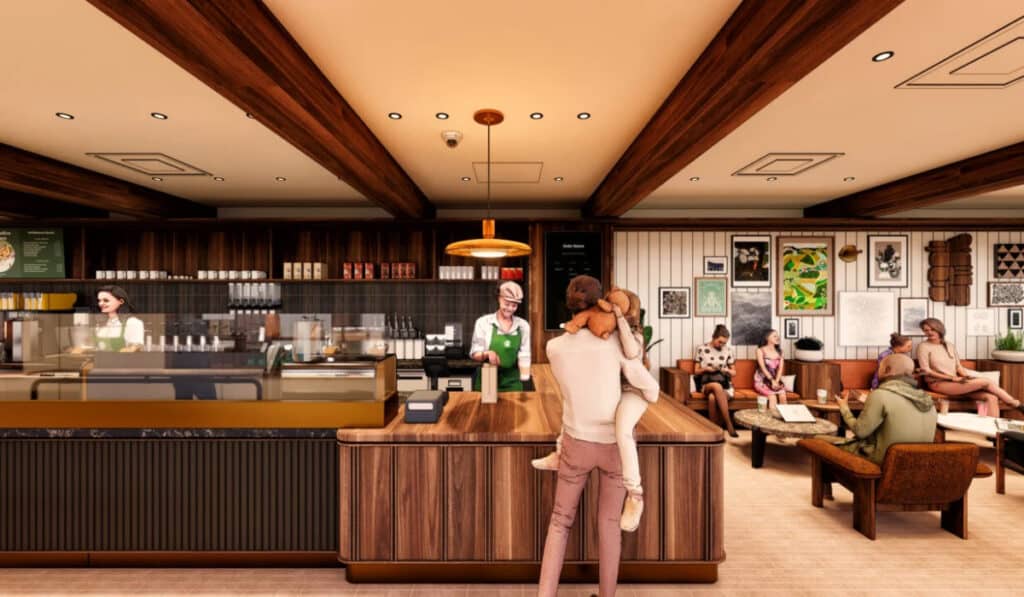
In the weeks and months to come, expect Starbucks to leverage its beverage pipeline. Summer Berry Refreshers with Pearls are returning alongside a new limited-time Horchata Oatmilk Shaken Espresso. Frappuccino-centric innovation, although not explained further, is on deck as well.
Down the line, Starbucks will center efforts on a test-and-learn approach (Chipotle-esque on that front, too) to build a culturally relevant innovation pipeline across F&B, Niccol said.
To do so, he added, Starbucks will develop “enduring platforms” that reshape the business and create lasting potential.
So, in the ensuing quarters, Starbucks will start piloting innovations that are sales driving, brand building, and designed for consistency, Niccol said. Work is underway to craft artisanal food, including how to freshly bake, assemble, and serve certain items in café at scale.
The company is using learnings from a launch of such products in the U.K. and overseas to inform a U.S. trial.
Next, Niccol hinted, Starbucks plans to explore “how to lead in health and wellness with a new platform that resonates across demographics.” That’s expected to arrive later this year, and the brand is looking at new beverages that create an entry point to craft coffee and drink experiences.
Aiming to further reclaim the “third place” and boost its afternoon daypart, Starbucks will also try an “aperitivo menu” that includes sparking beverages, sippable coffee drinks, and snackable bites.
Lastly, Niccol said, Starbucks began to move toward a more regular cadence of LTO flavor launches inspired by baristas and customers. “It’s early days,” he said, “but we’re moving quickly to improve the appeal of our product pipeline and to support real-time, culturally relevant menu innovation.”
Starbucks is also nearing its goal of rolling digital menuboards across the U.S. company-run system over the next 16 months (currently in 25 percent). These, Niccol said, represent a key unlock to marketing dayparts differently and introducing innovation that isn’t tied to Starbucks’ seasonal product cycles.
There is evidence of progress on the top-line from these abundant initiatives. So far in April, Niccol said, nearly 42 percent of domestic locations are generating positive comps, and about half are doing so in the morning.
From Q1 to Q2, the percentage of stores with positive transaction trends climbed by about 80 percent. It lifted from 13.5 percent or so to nearly 25 percent. “We’re making great progress, both across the system with the Back to Starbucks programs just on getting back to being focused on the customer, simplifying the operation for our partner, and then being very crystal clear on what are the things that we need to be spending our time on,” Niccol said. “And that is all around providing a great coffee house experience. And I think we’re starting to see it in the results.”


